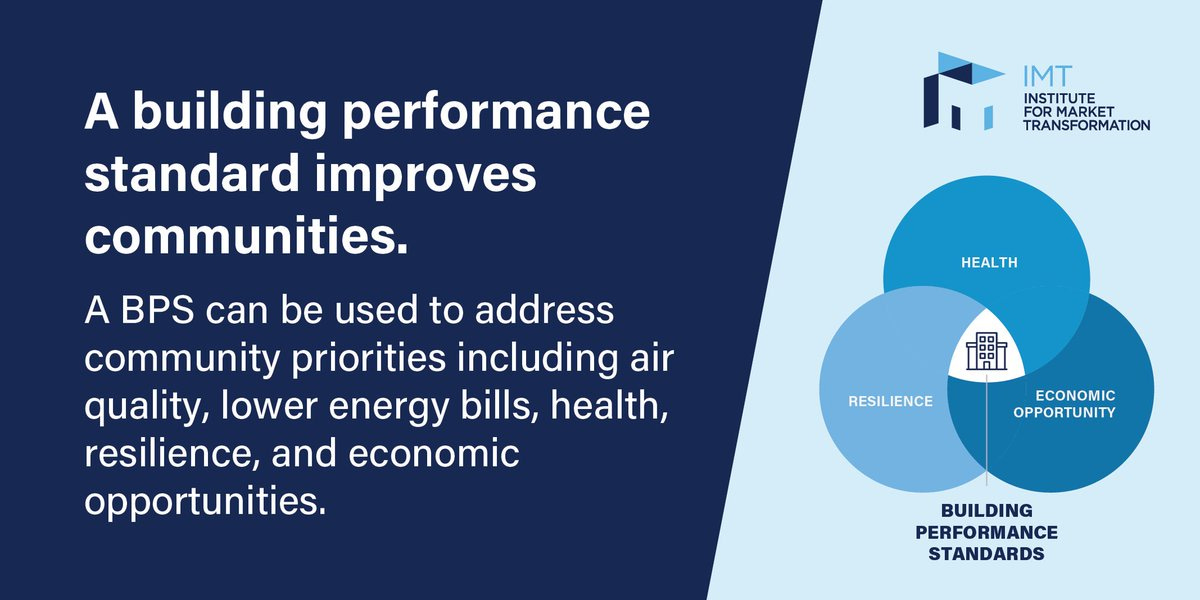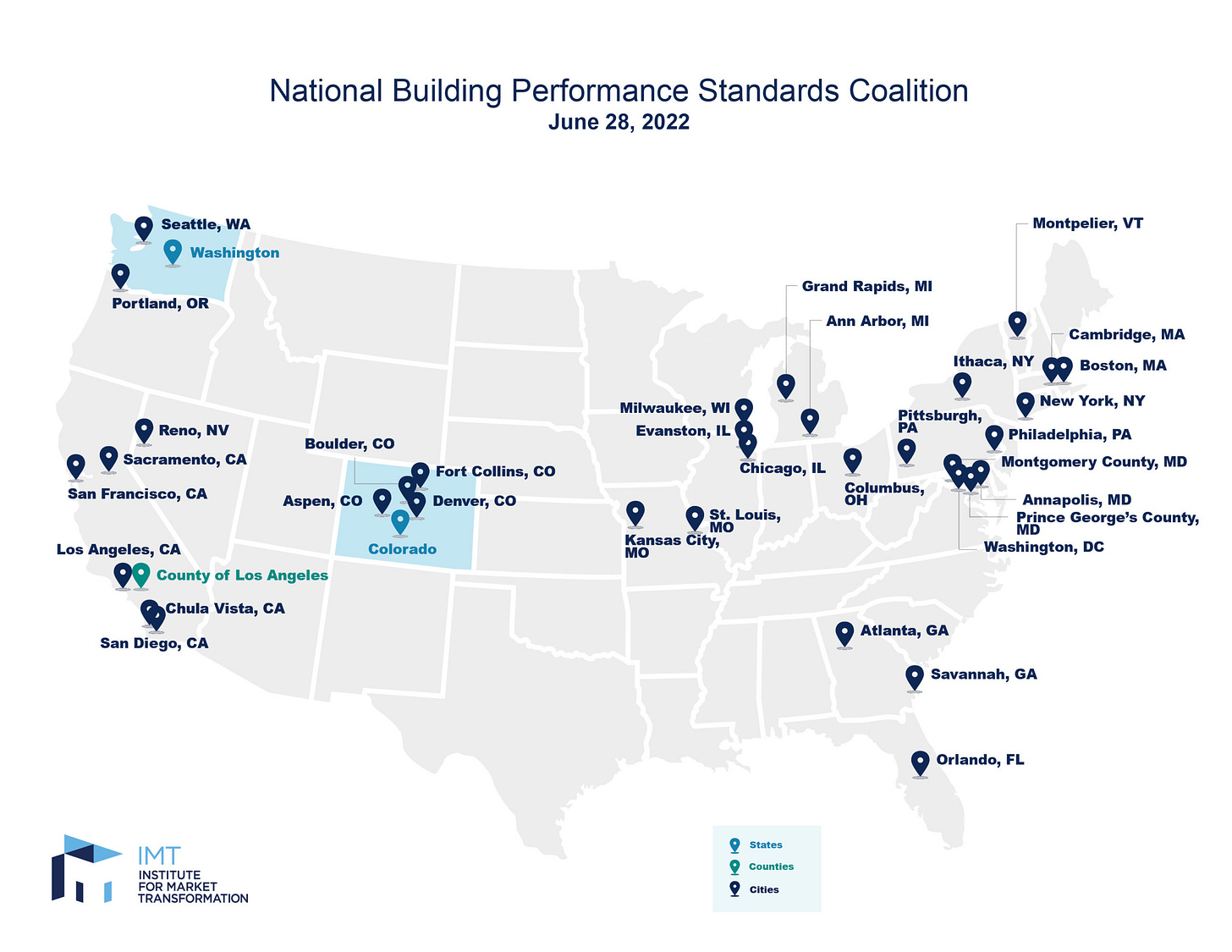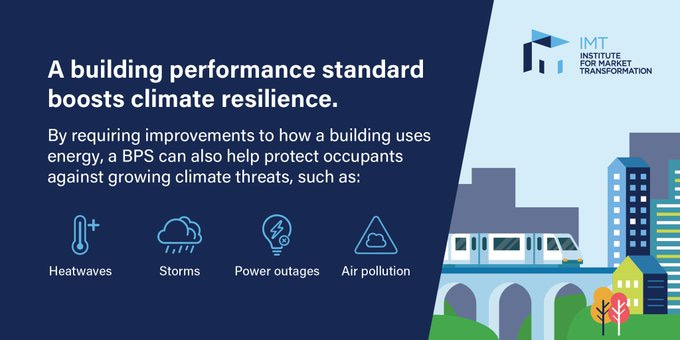Building Performance Standards Compliance Strategy?
"If you can't measure it, you can't improve it".... Peter Drucker
If you work in real estate, have you heard of the National Building Performance Standards Coalition (National BPS Coalition)? If not, you probably should be. The National BPS Coalition consists of 37 city and state leaders who have publicly committed to implementing building performance laws by EarthDay 2024.
The Coalition works a bit differently from the state, county, or city sustainability plans, which often feature a requirement to report energy consumption and can focus on buildings, transportation, land use, and other elements. Instead, the National BPS Coalition integrates into existing sustainability plans and focuses specifically on building energy performance.
The National BPS members represent states and local governments in the following locations:
What is a building performance standard, you might be asking?
“Building performance standards are state or local laws that require Building performance standards are state and local laws that require existing buildings to achieve minimum levels of energy or climate performance.” (source)
To get an idea of what those laws might look like, we can look at the 3 of the 11 current jurisdictions with regulations on the books:
Boston (BERDO 2.0): The minimum standard of action for BERDO is a 15% reduction in total site energy consumption, site energy use intensity, or total greenhouse gas emissions, or a 15-point increase in Energy Star score over five years. This improvement is verified through the annual BERDO reporting. Fines for failure to meet the standard may be up to $1,000 per day, and inaccurate reporting could result in up to $5,000 per day. There are multiple paths to compliance.
Washington DC (BEPS): Building on the benchmarking standard in place, BEPS contains multiple compliance cycles, with each cycle taking in smaller and smaller buildings. BEPS leverages the ENERGY STAR score by building type, so for multi-family, a score of 66. Meeting or exceeding the prescribed ENERGY STAR score for the building type is the standard pathway for each property type. If the score does not meet the standard pathway, there are three alternate pathways for compliance:
Performance pathway – the project must achieve a 20% reduction in site EUI.
Prescriptive pathway – the project must follow specified efficiency measures which will be released in a future guidebook.
Alternative Compliance path – project works with DOEE to create a custom pathway for compliance.
Fines for non-compliance are based on building size, topping out for a 500,000 square-foot building at $7.5M, and starting for a 25,000 square-foot building at $500,000.
New York City (LL 97): LL97 places carbon caps on most buildings larger than 25,000 with the goal of reducing emissions by 40% by 2030 and 80% by 2050. Compliance requires calculating and reporting the building’s emissions, which begins in 2025. A limit of kg CO2 eq/sf/yr is set for each 5-year period (2024-2029 {6.75 kg CO2 eq for multifamily} & 2030-2034 {4.07 kg CO2 eq for multifamily}). There is a fine of $268 per metric ton above the threshold. Fines for missing the reporting data can reach $50,000 per month, and filing a false report can result in a $500,000 fine plus 30 days of imprisonment. The fines depend entirely on the performance of the building but could exceed $1M per year for the worst polluters.
We can learn some common factors from lessons on how these existing laws are structured. The first is the need for energy data, and the laws tend to build on existing benchmark reporting laws that compel utilities to provide whole building data.
Without energy data, there is no ability to report. Unlike the prior benchmark reporting laws, however, the fines for non-compliance, missing deadlines, or falsifying reports are significant and can reach seven figures.
Another common element, whether reducing energy consumption or emissions, is that the building owner or manager will need to track the performance of the asset and project out the trend line of the building in order to assess if the performance requirement will be met.
This is where expertise will be needed to evaluate the compliance requirements and the current consumption trendline and project where the building will line up against the performance requirement.
Ideally, this expertise can extend to helping determine what energy efficiency measures can be implemented to reduce consumption and put the building on track toward compliance.
This is not a fix-it-and forget-it solution. Buildings drift; in fact, after three years without regular preventative maintenance, a LEED-certified building can consume the same amount of energy as a non-LEED-certified building.
Case in point: Vista PEAK Preparatory, a 216,000 SF school in Aurora, Colorado. This building was certified as a LEED Gold building in 2011. Four years later, the energy use intensity of the building had doubled, climbing from 35,000 Btu per square foot to 65,000 Btu per square foot (source).
This means tracking needs to continue throughout the ownership of the asset, with an eye on trends to address drift before it spirals the building out of compliance.
Benchmark Reporting Laws are important to comply with, and having a plan to submit that data is important; however, keeping an eye on Building Performance Standards is critical. The fines are significantly increased, and the level of complexity for compliance (as well as the amount of time it may take to comply) is also increased.
You can help reduce the built environment’s impact by sharing this blog with your peers. Together we can impact the 39% of greenhouse gasses attributed to the built environment. It starts with awareness, and we succeed with teamwork.
Stay well!
Chris Laughman is the ThirtyNine Blog author, a blog dedicated to reducing the built environment’s impact. When not blogging, Chris is helping residents, clients, and investors reduce their energy, carbon, waste, and water impact as the Senior Director of Energy and Sustainability for Greystar. Our team’s insight into the utility consumption of our managed and owned portfolios provides insight into opportunities to identify and mitigate risk. We leverage innovation and experience to ignite solutions with real impacts while tracking performance, ensuring the trendline stays laser-focused on the goal. All of us in real estate have a tremendous opportunity to make a difference in the built environment. Standing shoulder to shoulder, we will get this done. I can be contacted at: chris.laughman@greystar.com for questions, concerns, or collaboration.
The opinions expressed in this blog are my own.
Follow us at:
Twitter: @BlogThirtynine
Instagram: ThirtyNine_Blog







